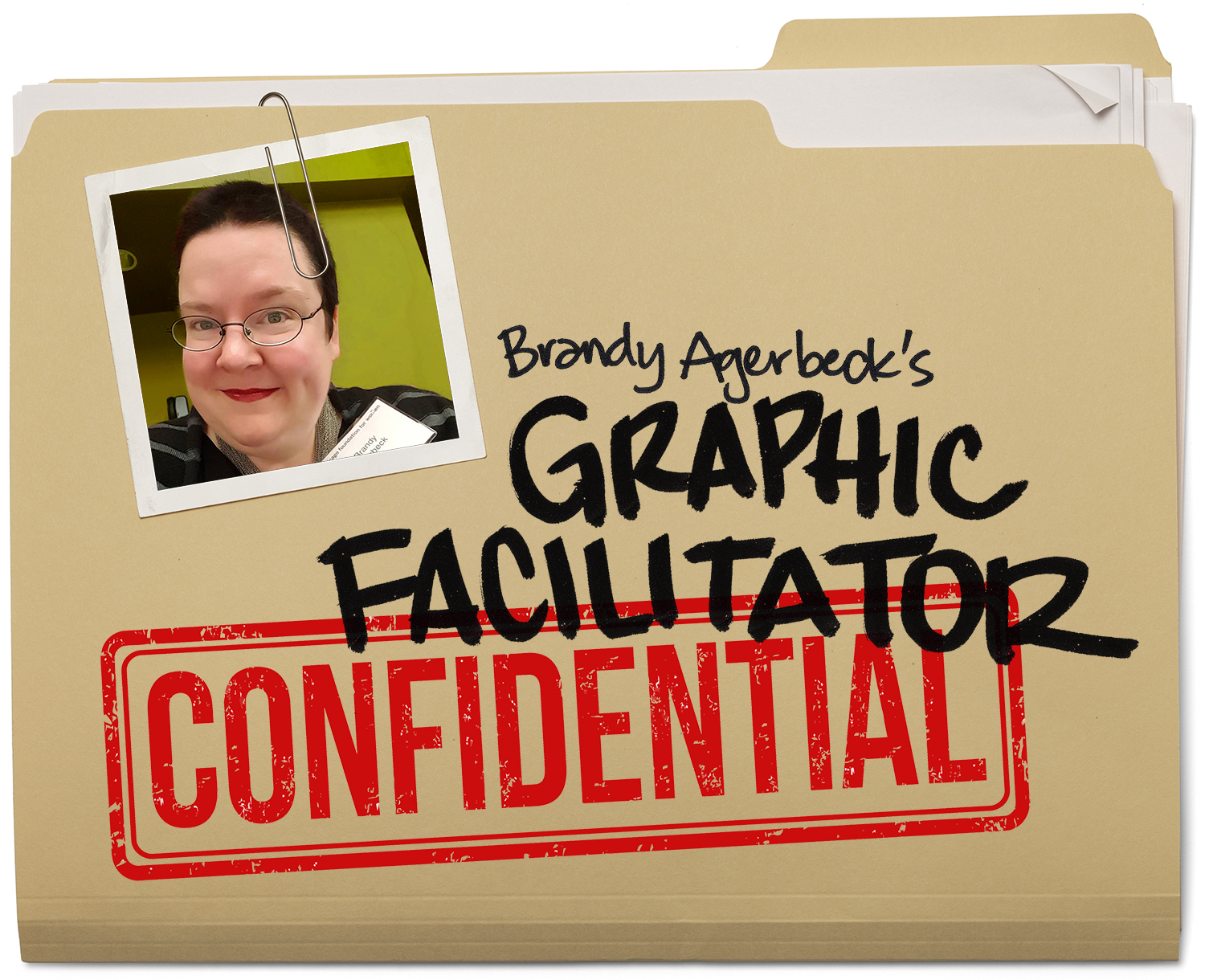How do I build my graphic facilitation portfolio?

I'm just beginning my graphic recording career. How do I build up my portfolio when I've only done a handful of projects? And the gigs I've done are internal meetings. HALP!
We all start somewhere.
Read on to learn:
- 4 ways to build your portfolio now
- Getting the AOK to share from your client
- The #1 principle to attracting the work you want
- 1 Do and 1 Don't to attract clients through your online portfolio.
Graphic facilitation (aka graphic recording, visual-notetaking, scribing) is live listening, thinking, and drawing in front of live humans.
If you are not working live, how do you show samples of your work to get to work live? And get paid.
Think more broadly and there are COUNTLESS ways to build out a portfolio to attract clients.
Over time, swap out your samples to make a stronger and stronger portfolio that best represents you and the kind of work you want more of.
1 | Ask permission from the clients you DO have.
Do not assume that past work is fair game.
Portfolio-building is a challenge because very often we're supporting internal meetings. Chock full of proprietary information and private discussion.
Internal meetings
When mapping closed meetings, take a step back from your work on break. Do you see a chart that is portfolio-worthy?
If yes, is there internal information anywhere on the chart?
A lot of it? → Skip it. But take notes on what works well in the chart. Do more of that.
A lil bit? → Ask your client on-site with a promise of following up.
"I'd like to add this chart to my portfolio. I see a few proprietary points I'd like to blur out. If you're open to the idea, can I follow up with a scrubbed version and make sure I have permission to share?"
As succinctly as possible, tee up the request onsite so it won't be out-of-nowhere or ignored later.
Follow through.
You can ask for:
⬜ ⬜ ✅ Permission to share the image publicly
⬜ ✅ ✅ Share with client name
✅ ✅ ✅ Share with client name and testimonial
The more checkboxes you can check, the more social proof you add to your work.
Public Programs
Definitely ask for permission! If the client posts your work online, be sure to link it.
2 | Volunteer for events specifically as portfolio-builders
Volunteering is the two-fer of portfolio building AND getting live, on-your-feet experience.
☝️ Note: I didn't also say "market yourself and get more work" above. In my experience, free work led to people who wanted more free work. Read Working for Exposure for my take on this.
While someone may ask you to donate your time, I recommend seeking out organizations and events to offer your time and skills to. Choose the kind of work you want more of.
As I shared in the article above, treat a freebie exactly like a paid project with a signed agreement and an invoice. It's more solid practice, shows your value, and you show up as the professional you are.
Definitely ask for:
✅ ✅ ✅ Permission to share the work with client name and testimonial
✅ Credit line, bio, and link in printed materials (when there is an event program)
✅ Permission to hand out your card to interested attendees.
✅ Distribution of your images to attendees with your credit line included.
Again, treat it like a paid project. Set expectations on both sides clearly up front.
Lastly, I would ask the client not to announce that you are donating your time when introducing you. That begets more freebie seekers.
3 | Go to public events and draw sketchnotes.
I did this for years, before the term sketchnotes. I would draw one page per talk in my 8"x8" sketchbook. I called it "real-time journaling."
Sketchnotes is snappier.
How did I choose events?
- Events whose audience matched my ideal client base
(I go into my details on this in my online course Graphic Facilitator Confidential.)
Organizational Development Network Impact Awards, 2004, 8"x8" - Events on topics of interest to ideal client base

Jackie Huba on Creating Customer Evangelists, 2002, 8"x8" - Events of personal interest
 Errol Morris at Chicago Humanities Festival, 2006, 8"x8." More on this work here >>
Errol Morris at Chicago Humanities Festival, 2006, 8"x8." More on this work here >>
Unless your person interests will repel clients...
Let's pause for an announcement:

I'll risk you saying "duh."
Fill and update your portfolio with the work you want.
Starting out as a freelancer involves saying yes until you figure out what you want to say no to.
That is part of the process.
Early on, you'll have items that aren't exactly where you want to go, but the pieces give a solid sense of how you work and what your work looks like. You post and promote that work.
Clients look at your portfolio looking for the kind of work they need.
As you build out your portfolio, keep swapping in the work that you are an enthusiastic YES to.
One caveat: Unless you truly only want work in one niche, have some variety in your portfolio of topics, client types, and types of events.
If your portfolio is all startups in biotech, potential clients could find your work and think, "Heck, I like their work. They clearly work with startups like us. But we're not biotech."
Again, clients look at your portfolio looking for the kind of work they need.

4 | Map out online videos or podcasts.
You don't even have to leave your house. There is zero excuse to not create portfolio pieces. 
President Barack Obama's Inauguration Speech, 2009, 3'x4,' Click here for more >>
You can work with a variety of content:
- Fast-paced, content dense TED talks and edited audio pieces
- Casual conversation of multi-host podcasts
- Interviews
- Panels of multiple guests
No matter what kind of work you are creating here is one "do," and one "don't" in building your portfolio:
DO NOT fill your portfolio is fuzzed out images or charts full of blurred out text.
I had a client say to me onsite, "I chose you because I could actually read your work."
DO share the context and process behind each of your pieces.
You'll be educating your potential clients about how you work best. Something you share may resonate with them and you rise to the top of their list. And you present yourself as a partner, not a commodity.

Want to learn more about business-building?
Check out: 


